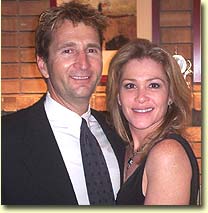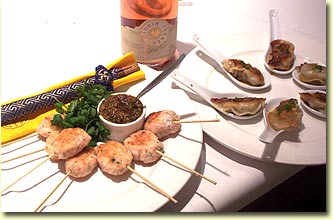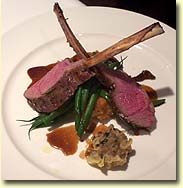
|
|
We had met prior to discuss the foods and we agreed on the following menu.
Californian Dinner Menu (click here for the chef's notes) Shrimp lollypops with
almond pesto Ahi tuna tartar with
grapefruit, avocado, salmon caviar, lemon grass cream and lobster oil
Soft
shell crab sandwich with green gazpacho, fried tomato and warmed arugula Pan seared salmon with
shitake mushroom risotto, pinot reduction and sweet pea emulsion. Pacific Rim Duck
confit with stir fry and Soy ginger sauce Roasted rack of lamb,
wild mushroom compote, foie gras siew mie and Half baked warm
chocolate molten cake with roasted pear, caramel sauce and crème
fraîche.
The event started in style as a couple of bottles of bubbly were iced and opened. Gloria Ferrier Carneros Brut Rose Below the nice creamy head of mousse sits a lightly bubbled pink/cranberry coloured wine that is perfect as an aperitif. It gives off clear aromas of red currant; yeasty freshly baked bread, red cherry, tart green apple skin and sweet plum pie. It is medium bodied, well balanced and lingers wonderfully on the palate. Its degree of acidity cleans the palate and works well with the appetizers.
Ch. St. Jean, Fume Blanc, la Petit Etoile Russian River Valley, 2002
I served a cold first course of tuna tartar; salmon caviar and lemon grass cream, hoping the Sauvignon would provide the level of acidity to enhance the seafood. As the wine was rounder than expected, it actually played along with the lemon grass cream and the crouton fried in lobster oil, rather than the fish. Ch. St. Jean, Chardonnay Reserve, 2001 Another rich and ripe toasty nose this time featuring Asian pear, vanilla and butterscotch. It has excellent depth of fruit, mostly white peach and pear along with an enduring touch of canned pineapple. It is medium to full bodied; the finish has layers of vanillin and buttery fruit. The wines rich/fat texture worked well with the soft shell crab sandwich. The almonds and pine nuts in the green gazpacho enhanced the wine, while the tomatillos, also in the soup, added a subtle touch of sourness. The salad component of the dish sucked, but hey it is January, what else should I expect. Ch. St. Jean, Pinot Noir, Durell Vineyard, Carneros, 2001
I had thought the classic Pinot and salmon match might work here. I popped a few funky wild mushrooms into the risotto, which I made with the last of my frozen tomato water from the previous summer. It was full of all sorts of flavour laden dried tomatoes and lots of fresh minced herbs. I think I might have gone overboard a bit on the flavour element in the rice, which might have overpowered the wine. Oh well, it was tasty. Ch. St. Jean, Merlot Reserve, 1996 (decanted three hours prior)
I think the opposite of the previous match occurred here, as I did not anticipate the Merlot to have quite the intensity that it did. I had made a confit of duck, which I served on a mildly spiced Pad Thai noodle pooled with a duck stock reduction flavoured with tangerine peel, star anise and a touch of chili pepper. I deliberately kept the sauce “delicate” as not to over power the wine. The duck and the wine had fun together, but I think the sauce never really played its role in the threesome. Ch. St. Jean, Cabernet Sauvignon, 2001 (three and a half hours in the decanter) A softer and simpler wine exhibiting medicinal aromas of sweet blackcurrant, spearmint, ripe plum and milk chocolate. It is drinking nicely; even the tannins on the finish are silky. Ch. St. Jean, Cinq Cepage, Sonoma County, 1999 (three hours in the decanter)
Although the Cinq Cepage has years of life left to, it gives much pleasure in its current state of maturity and it really was a no brainer to match with the lamb. As an added bonus, the vegetal and mineral components of the wine really hooked up with the morels I had added to the Madeira and lamb stock reduction. Ficklin Vineyard, Californian Port, Madera
Many thanks to Crystal Gimson and April Weiler, both culinary students of mine, who were kind enough to donate precious time away from studies to help me out. Cheers Alan Kerr's Home Page and Main Index
|

 On
most occasions when I am asked to orchestrate a dinner party, the menu
is the main priority. A client may also ask me to suggest specific wines
to go along with the foods or the theme we chosen to go with. However,
when I was recently asked to prepare a fundraising dinner where the
wines of Sonoma Valley’s Chateau St Jean
were to take the spotlight. I knew it would be both challenging and fun.
On
most occasions when I am asked to orchestrate a dinner party, the menu
is the main priority. A client may also ask me to suggest specific wines
to go along with the foods or the theme we chosen to go with. However,
when I was recently asked to prepare a fundraising dinner where the
wines of Sonoma Valley’s Chateau St Jean
were to take the spotlight. I knew it would be both challenging and fun.

 I
made spicy shrimp lollypops bolstered with fresh Serrano chilies, finely
minced lemon grass, Kaffir lime leaf and coconut. I played around with
Ming Tsai’s almond pesto recipe (Is there a link to this, or if not,
should we provide the recipe?) by increasing the heat and adding Thai
basil. The other appetizer was a lobster pot sticker. I used the shells
to make a lobster emulsion to coat them and I also made lobster oil for
one of the ensuing courses. Both of these nibblies worked with the
bubbly nicely as the effervescent character of the wine tamed the degree
of heat in the food.
I
made spicy shrimp lollypops bolstered with fresh Serrano chilies, finely
minced lemon grass, Kaffir lime leaf and coconut. I played around with
Ming Tsai’s almond pesto recipe (Is there a link to this, or if not,
should we provide the recipe?) by increasing the heat and adding Thai
basil. The other appetizer was a lobster pot sticker. I used the shells
to make a lobster emulsion to coat them and I also made lobster oil for
one of the ensuing courses. Both of these nibblies worked with the
bubbly nicely as the effervescent character of the wine tamed the degree
of heat in the food.  This
is not really what I expected to find in this wine. Although it was
pleasing, it has few of the typical nuances I expect from this varietal.
Its nose is quite spicy and shows off roasted pear, ripe melon,
grapefruit peel, Mack apples, and a toasty, steely, mineral element. It
has flavours of mandarin orange, canned fruit and it’s surprisingly low
in acid. I like it; it is just not what I expected.
This
is not really what I expected to find in this wine. Although it was
pleasing, it has few of the typical nuances I expect from this varietal.
Its nose is quite spicy and shows off roasted pear, ripe melon,
grapefruit peel, Mack apples, and a toasty, steely, mineral element. It
has flavours of mandarin orange, canned fruit and it’s surprisingly low
in acid. I like it; it is just not what I expected. At
first approach, I do not like this very much. It appears to be metallic
and thin. However, as it sits in the glass the true varietal character
begins to show nicely. It picks up warm creamy red currant and fruit
confit aromas that soon change to cooked rhubarb and cola. On the palate
it is mostly fruit driven, showing good extraction, but there is a level
of tannin that appears to be quite chewy. At this stage it is a touch
too spicy and warm on the finish for me.
At
first approach, I do not like this very much. It appears to be metallic
and thin. However, as it sits in the glass the true varietal character
begins to show nicely. It picks up warm creamy red currant and fruit
confit aromas that soon change to cooked rhubarb and cola. On the palate
it is mostly fruit driven, showing good extraction, but there is a level
of tannin that appears to be quite chewy. At this stage it is a touch
too spicy and warm on the finish for me.  This
is clearly the most powerful and multidimensional wine of the night. Its
nose surrenders sweet lavender, green moss, mushroom and thyme. There is
an element of aquarium that begins to show after minutes in the glass.
On the palate it reveals a heady plum note with milk chocolate, creamy
toffee and dark berry. The layer of fruit on the finish shows power as
it turns to a toffee caramel quality. I like this wine.
This
is clearly the most powerful and multidimensional wine of the night. Its
nose surrenders sweet lavender, green moss, mushroom and thyme. There is
an element of aquarium that begins to show after minutes in the glass.
On the palate it reveals a heady plum note with milk chocolate, creamy
toffee and dark berry. The layer of fruit on the finish shows power as
it turns to a toffee caramel quality. I like this wine.  I
expected this to be a fruit driven, palate whacking oaky monster, but I
am pleasingly surprised. The nose exudes aromas of lead pencil,
blackberry, sweet cherry, mineral, underbrush and dried herbs de
Provence. It has an elegant mid palate that balances the fruit and
vegetal components wonderfully. It finishes with a trace of mineral,
liquorish, milk chocolate tannin and lots of dark berry fruit. Good
stuff.
I
expected this to be a fruit driven, palate whacking oaky monster, but I
am pleasingly surprised. The nose exudes aromas of lead pencil,
blackberry, sweet cherry, mineral, underbrush and dried herbs de
Provence. It has an elegant mid palate that balances the fruit and
vegetal components wonderfully. It finishes with a trace of mineral,
liquorish, milk chocolate tannin and lots of dark berry fruit. Good
stuff.  I
have had this wine in my cellar for as long as I can remember and I
brought it along just to see what, if anything, was left. Big surprise,
after effortlessly removing the totally moistened cork, I found the wine
to be quite lively and delicious to boot. It is rusty in colour. The
nose gives off an aroma of orange, mandarin chocolate bar, crème brulee,
sweet cinnamon, anise seed, vanilla pod and a faint touch of burnt
rubber. It is still remarkably active on the palate and the finish has
no excessive heart or dried out qualities.
I
have had this wine in my cellar for as long as I can remember and I
brought it along just to see what, if anything, was left. Big surprise,
after effortlessly removing the totally moistened cork, I found the wine
to be quite lively and delicious to boot. It is rusty in colour. The
nose gives off an aroma of orange, mandarin chocolate bar, crème brulee,
sweet cinnamon, anise seed, vanilla pod and a faint touch of burnt
rubber. It is still remarkably active on the palate and the finish has
no excessive heart or dried out qualities.  By
now, I noticed people were getting rather full. It was best to ration
Crystal’s rich and decadent chocolate ganache torte to a meager sliver.
The degree of sweetness in both wine and dessert were on par. To my
surprise, I think it was the match of the night. Jim and his partner
Carla, both get my praise for the generosity they showed by hosting this
event.
By
now, I noticed people were getting rather full. It was best to ration
Crystal’s rich and decadent chocolate ganache torte to a meager sliver.
The degree of sweetness in both wine and dessert were on par. To my
surprise, I think it was the match of the night. Jim and his partner
Carla, both get my praise for the generosity they showed by hosting this
event.